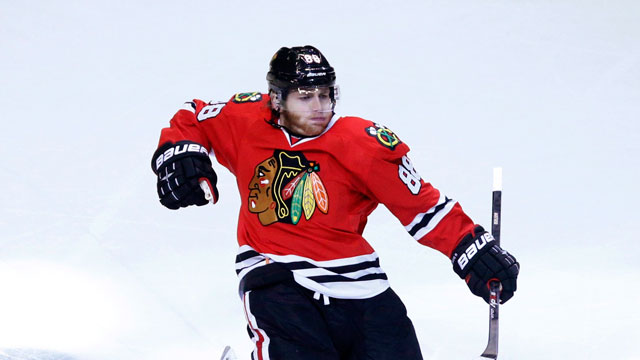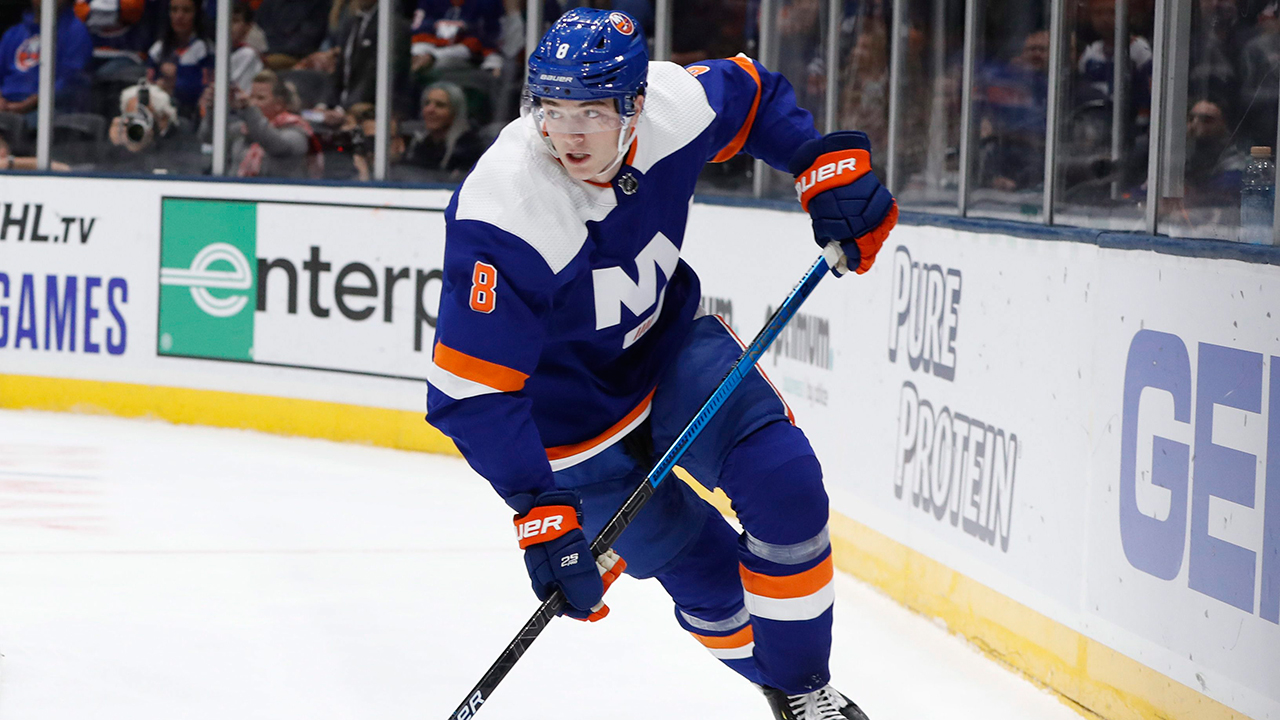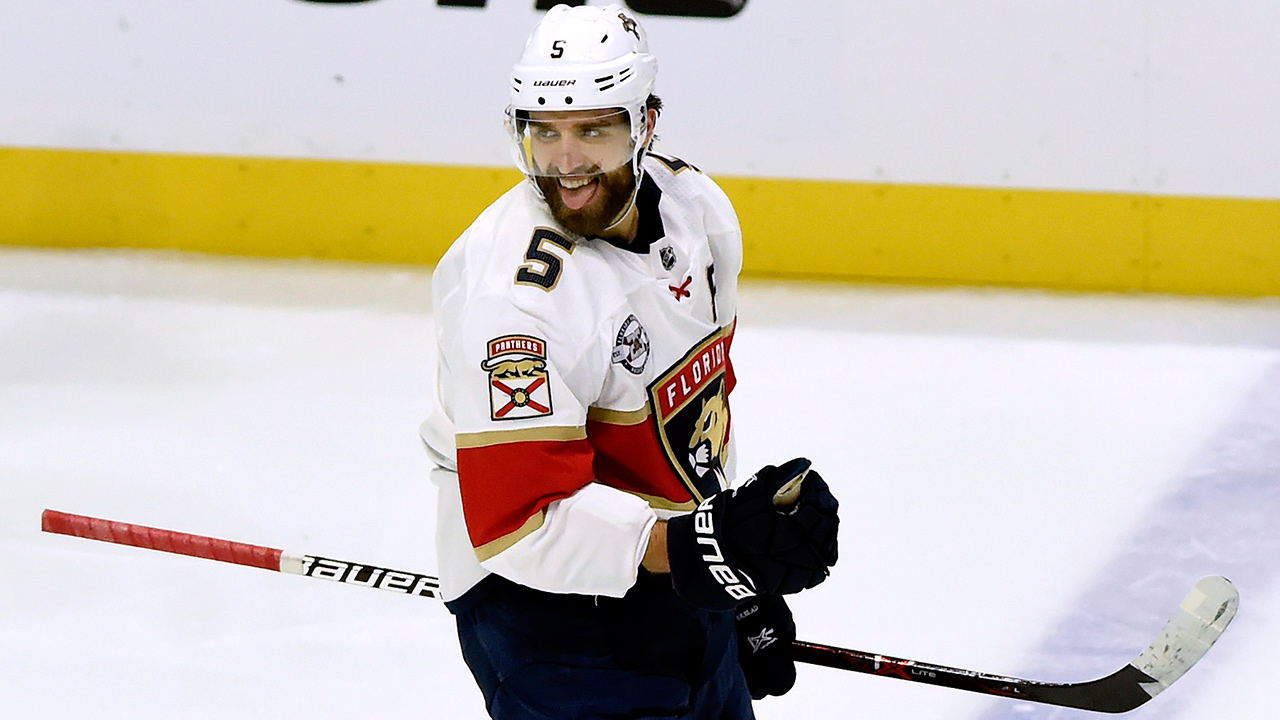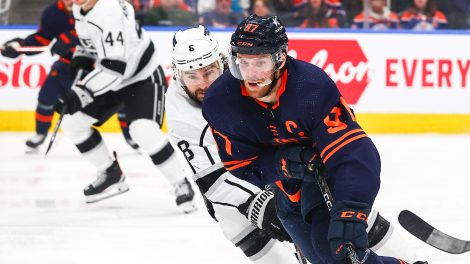Chicago is no stranger to superstars who thrive in the spotlight. This year, the eyes of the hockey world are all on the Blackhawks, and Patrick Kane is more than ready for his close-up.
Wayne Gretzky loved to curl toward the boards once he crossed the blueline, but Patrick Kane’s manoeuvre is more of a shuffle. A couple of times each game, Kane will carry the puck through the right side of the neutral zone, watch defencemen back off a little more than they do for other players—even good ones—then downshift right near the top of the circle. There, Kane makes a little half-pivot and starts a delicate lateral movement, his left-hand shot menacingly keeping the puck near the middle of the ice as he cradles it back and forth. It’s like watching a pro golfer waggle his five-iron before sticking a shot three feet from the pin. The details of his plan are never obvious; it could be a seeing-eye pass, a sneaky shot on goal or a quick speed burst to set up shop somewhere else. But in that moment, five teammates, six opponents, two benches and 20,000 fans are fixated on Kane, some wondering what comes next, others dreading it. Those glares can be searing, but for the Chicago Blackhawks’ cocksure magician, centre stage is the best place in sports.
That Kane relishes the spotlight is already well known in Chicago, which ended a 49-year Stanley Cup drought in 2010 when No. 88, at just 21, slipped the game-six overtime winner past Philadelphia Flyers goalie Michael Leighton to clinch the series. It was only three years ago that the Hawks hoisted the Cup, but it feels much longer given the club’s significant turnover since the parade up Michigan Avenue. Both Kane and the Hawks have taken some lumps in the interim, but the team has finally replenished the ancillary elements that were missing the past couple of seasons. Meanwhile, Kane, a touch older and wiser, remains defined by the skill that makes him the most dazzling American player in the game, and by the confident swagger befitting that label.
After a Friday-morning skate in the regular season’s final flickers, the dynamic between stars and supporting cast is on display in the Chicago dressing room—and it’s entertaining to watch. Seated side-by-side are Kane and second-year Blackhawk Andrew Shaw. The former holds court with a horde of reporters; the latter faces just a single scribe. The crowd around Kane dissipates just as Shaw is asked about how playing in a big, Original Six market seems to suit his neighbour well. It’s clear both players have heard the question, which triggers a hesitant half-smile from the suddenly tongue-tied Shaw. Kane, just like he does on the ice, exploits the smallest of spaces to take over. While Shaw balks, Kane slowly invades his teammate’s locker, taking his sweaty, red practice jersey and hanging it on Shaw’s hook. If the message here playfully reinforces the team’s hierarchy, it’s nothing like the genuine encouragement Kane consistently gives the scrappy, third-line centre. “He’s always just telling me, ‘Keep doing what you’re doing; I love it, they love it,’” Shaw says. “He’s in my ear about it all the time.”
Kane’s enthusiasm isn’t just an endorsement of Shaw’s play; it’s indicative of the rink rat’s overflowing passion for the game. There is ample evidence of that zeal—some of it quiet, like the way he attends the overwhelming majority of optional skates just to be on the ice, some of it much more visible, like the way he uppercuts the air after goals. “He’s got some of the biggest, most flamboyant celebrations in this locker room and maybe around the league, too,” says captain Jonathan Toews.
That flair has always made Kane a favourite of adolescent fans. His agent, Pat Brisson, says he’s always leaning on his client to find out what intrigues teenagers because Kane is plugged into youth culture. In addition to his style on the ice, the fact that Kane still looks young enough to cut Grade 11 chemistry also likely endears him to that demographic. Brisson jokes that Kane is “half Canadian” because he grew up in Buffalo, frequently hopping the border for hockey tournaments. But there’s an unmistakable and unapologetically American aspect to his character. Kane isn’t publicly loose-lipped in the cut of other brash Yankees like Brett Hull or two guys who once wore the same uniform he does, Chris Chelios and Jeremy Roenick. Instead, his attitude shines through in a wonderfully cocky grin, and in the way he sees the game—perhaps more than anyone in the NHL—as a series of individual confrontations. He happily and effectively utilizes teammates, but it’s appropriate that Kane is a basketball fan, because his mentality is that of a big-time NBA scorer, a guy who wants the ball, wants to use his immense athleticism to shake loose and drop the winning shot. Michael Jordan used to do it in the same arena where Kane plies his craft, and if you squint enough at the hockey player, his mouthguard protruding the way Jordan’s tongue used to, you see shades of the hoopster who believed he could and should beat you every time—but especially when it mattered most. “He’s the guy who wants the puck at the end of the game,” says Hawks GM Stan Bowman. “He’s the ultimate pressure player. The bigger the game, the better he plays, and that’s a tough thing to do. There are a lot of people who shy away from that.”
In addition to famously bagging the Cup-winner in 2010, Kane entered this post-season with 52 points in 51 career playoff games. He had five points in six contests at the 2010 Olympics for Team USA and during his only World Junior Hockey Championship in 2007, Kane potted nine points in seven outings. “You’re only considered one of the best if you come to play in big games,” Toews says, “and he obviously wants to prove that.”
It’s easy to overlook the fact that Kane is a seriously committed player. There’s a tendency to glance at anybody drafted first overall, as Kane was in 2007, and assume things came easily for him. But Kane was not regarded as a top-of-the-draft NHL talent when he joined the Ontario Hockey League’s London Knights for the 2006–07 season. Certainly, there was a correlation between increased exposure and his stock rising, but he also had to prove his talents as an undersized major junior player (he measures just five-foot-11) under the scrutiny that comes from being a high-profile U.S. import. “A lot of people know him for being a jovial, laid-back, fun guy, but when it comes to hockey, he takes it very seriously,” says teammate Jamal Mayers.
That’s why, instead of just playing some pickup during the lockout last fall, he packed his bags to go play in Switzerland. His two favourite things to do there were score points for his adopted squad, Biel, and pester Brisson constantly, hoping to get word this annoying work stoppage was over so he could resume the life he loves. Kane was extra motivated last summer, coming off the least-productive season of his NHL career. But working hard in the off-season—specifically with skills coach Darryl Belfry—is a habit of Kane’s, something that’s helped him have fast starts to the season throughout his career. The past two years have seen a spike in Kane’s strips, as he’s been hovering around the league’s top 10 in takeaways. “Each year, he would kind of work on a different thing,” says Bowman. “It’s an evolution for him.”
That process has included lessons away from the rink, too. There was no trademark grin on Kane’s face on that August day in 2009 when he left a courtroom after pleading guilty to a non-criminal charge of disorderly conduct stemming from an incident in which he and his cousin, James Kane, engaged in an early-morning confrontation over a fare with a Buffalo taxi driver. In May of 2012, Deadspin provided photo evidence and firsthand accounts of Kane’s alcohol-fuelled antics in the college town of Madison, Wis. While there was no formal fallout, the attention certainly wasn’t flattering and merited some talks with his agent and GM. Brisson said he’s seen athletes head down the wrong path before and doesn’t believe Kane is in danger of following suit: “I wasn’t worried, I’m not worried.”
What both Brisson and Bowman did stress to Kane is that, in today’s quick-capture world, behaviour of any kind can easily be documented and publicized. Nobody talks about a then-and-now change in Kane, but Bowman does think he was interested in altering some of the conversations about him. “His play on the ice [this year] has deserved a lot of talk,” Bowman says, “and I think that’s what he wanted to do: ‘Let’s talk about what I can do when I have the puck on my stick.’”
Sticking it to the naysayers is a widespread theme in Chicago. Beyond the star player strutting his stuff, the team is looking to shirk their recent underachieving label. Bowman says the team should be proud of the regular seasons it has put together the past two years, but the playoff results have left something to be desired. In 2011, the Hawks pushed the eventual Western Conference–champion Vancouver Canucks to the brink, only bowing out in overtime of game seven. Last spring, Chicago was bounced in round one by the Phoenix Coyotes, further entrenching a sense that something had to change. “I think we had a bit of a chip on our shoulder from last year,” Kane says of the Hawks’ 2013 approach.
At times, other emotions might have been at play, too. The decision to purge big parts of the roster—players like Kris Versteeg, Andrew Ladd, Dustin Byfuglien and Brian Campbell—came down to nothing more than cold economics. Bowman and the Hawks had to find a way to comply with salary-cap constraints. But even though there was no alternative to taking action from a management perspective, that doesn’t mean it was easy on the dressing room. “I think there was a certain mourning period this team went through,” says Mayers, who signed with the Hawks in July of 2011.
While Kane, Toews, Marian Hossa and Duncan Keith have remained the central figures, the periphery is now packed with young, hungry contributors like rookie left winger Brandon Saad, defenceman Nick Leddy and Shaw, who became draft-eligible in 2009, but wasn’t selected until the fifth round of 2011. “He’s always sort of been the underdog,” says Bowman. “He’s probably always been told he’s not big enough or that there are other guys who are better, and he’s always proved them wrong. He’s got that inner fire.”
Some hockey people believe it was stoked by the slight of falling through two drafts, but Shaw is quick to point out his game has always been a beautiful form of ugly. It’s also pretty diverse. For the most part, he’s lined up on the third line between Bryan Bickell and Viktor Stalberg, but he’s also bounced around the lineup, sometimes swapping out to the wing, always bringing a mix of grit and skill that ingratiates the 21-year-old to his bosses. “He’s really smart and the coaches trust him,” Bowman says. “He’s done an awful lot in a short career and he’s hungry to do more.”
The same could be said for Saad, who has the highest ceiling of the newcomers and was among the top freshmen in goals, points and plus-minus this year. A second-rounder in 2011, the Pittsburgh native has typically found himself on the top line with Toews and Hossa, which sounds like a plum assignment, but isn’t just a plug-and-play scenario. “I know it sounds funny, but sometimes it’s hard to play with two elite players,” Bowman says. “They’re obviously thinking the game faster than everybody else and they’re expecting you, when you get a pass, to get the puck back or to go to the right spot. From the beginning, it’s just clicked with him. A lot of nights he’s right there, helping carry the line. It’s not like they’re carrying him.” Mayers sees similarities to one of his former teammates in San Jose. “He’s very strong on the puck, deceivingly fast,” he says. “He kind of reminds me of Patrick Marleau. The sky’s the limit.”
Throw in the quick feet of Leddy, strong goaltending from Corey Crawford and Ray Emery and the continuing development of Bickell—a rugged six-foot-four, 233-lb. hit machine who played just four playoff games in 2010—and it’s easy to see why a Cup redux is firmly on the brain in Illinois. “They put a lot of that grit and spit back in their lineup to balance out a very talented group of players,” says Barry Trotz, coach of the division-rival Nashville Predators. “From afar, they have all the elements to do something special again this year.”
They already have, of course, setting a new NHL record by recording at least a point in each of their first 24 games to start the season en route to capturing the Presidents’ Trophy as the top regular-season team. Those achievements notwithstanding, there remains an inescapable shadow cast by the 2010 outfit that took it all, and while Mayers acknowledges that, he stresses this club is much more than a cheap knock-off of the original. “Ultimately, we’ll be measured against that team that won, but I think we’re a great team in our own right. The new guys who are here have formed our own identity, and this is our team, this year, 2013, and we’re going to make a run for it.”
For all the necessary contributions from complementary players, the heavy lifting still falls on the same handful of stars. In addition to Kane’s exploits, Toews finished the regular season a point-per-game player for the first time in his career. Hossa returned from a serious concussion to find his two-way game still intact, and Keith remains a smooth-skating lynchpin on the blueline. “Their top guys are always going to be driving the bus, and they’ve been great,” says Phoenix captain Shane Doan. “When that happens it makes everyone look a lot better.”
The Blackhawks aesthetic is rarely more pristine than when Kane is doing his thing. Brisson, in a nod to his artistry, calls him Picasso. “He’ll create room for himself like no one in the NHL,” he says.
Inside the Hawks’ room, Kane is surrounded by teammates who love that he makes coming to the rink a bit more fun. Outside the arena, he breezes past bronze reminders of greatness. Right in front of the gate where players enter the United Center, Jordan’s exploits—he led the Bulls to six titles—are immortalized with a statue that forever freezes him in his vintage dunk pose. Just around the corner, a pair of red-tinged monuments pay tribute to Hawks greats Bobby Hull and Stan Mikita. When Chicago ended a 23-year Cup drought in 1961, Hull and Mikita, at the time just 22 and 21, respectively, were expected to be in the middle of many more championships. It never happened. More than 50 years later, the tension is mounting around a talent-rich Hawks team to prove it’s not a one-and-done outfit, that it can yet be a multi-title, modern-day dynasty. It’s a lot of pressure, which means we should soon be seeing the best of Kane. “He wants the responsibility, he wants to be out there, and he’ll get it done,” Bowman says. “That comes from within. That’s who he is. That’s what makes him special.”
This story originally appeared in Sportsnet magazine. Subscribe here.










